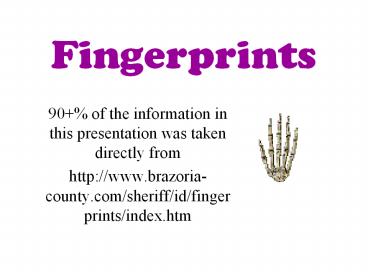Fingerprints - PowerPoint PPT Presentation
Title:
Fingerprints
Description:
Fingerprints 90+% of the information in this presentation was taken directly from http://www.brazoria-county.com/sheriff/id/fingerprints/index.htm – PowerPoint PPT presentation
Number of Views:187
Avg rating:3.0/5.0
Title: Fingerprints
1
Fingerprints
- 90 of the information in this presentation was
taken directly from - http//www.brazoria-county.com/sheriff/id/fingerpr
ints/index.htm
2
Ancient History is a mystery
- Suggested that thumbprints on Babylonian clay
tablets and ancient Chinese clay seals were
deliberately placed there as identifying marks
3
Sir Francis Galton
- Established that fingerprints are unique.
- Wrote book Fingerprints
- This introduced modern techniques of criminal
investigation, replacing tatooting, branding, and
body measurements as methods of identifying
criminals.
(Charles Darwins Cousin)
4
Galtons Premises(or Galton Details)
- First to categorize minutia and observe that they
remain unchanged. - Uniqueness
- All Fingerprints are different
- Nature does not repeat any object in complete
detail. - Permanence
- Fingerprint patterns remain constant as a person
matures. - Superficial skin damage grows back to original
- Severe cuts and resulting scars remain permanent.
5
Sir Edward Richard Henry
- Developed a method of indexing fingerprints
Henry Classification System. - Problem need all 10 prints
- Book Classification and Uses of Fingerprints
- Classifies fingerprints into three types Arches,
Loops, and Whorls
6
Johannes Purkinje
- In his doctoral thesis, he identified nine print
patterns - Arch
- Tented arch
- Loop
- Six Whorls
7
(No Transcript)
8
(No Transcript)
9
The basic tenets of friction skin identification
areFriction skin is UNIQUEFriction skin
develops before birth, is PERMANENT and NEVER
CHANGESVariation in ridge patterns vary within
specific limits and can be classified.
10
ACE-V
- Analysis
- Comparison
- Evaluation
- Verification
The generally accepted method for friction
ridge individualization
11
RIDGE Detail
1st Level Detail
2nd Level Detail
3rd Level Detail
12
(No Transcript)
13
14
Where to look for minutiae
- The area immediately surrounding a delta will
probably contain more points per square
millimeter than the area near the tip of the
finger which tends to not have that many points.
15
Finding Minutiae
- These are only 10 of the 22 in this ¼ X ¼ inch
section.
16
Finding Minutiae
- May not be all that easy. In real life,
impressions - are made at separate times.
- are subject to different pressure distortions.
- from a crime scene are anything but clear.
- from a crime scene could be a fingertip, palm or
even foot impression, not the core of a
fingerprint.
17
Classification
- Ya gotta be able to find the delta(s) or
recognize a lack of them! - Deltas
- a place where two lines run side-by-side and
then diverge with a significant recurving line
that passes in front of the delta.
18
Classification Based on Deltas
- If the print has one delta then the pattern is a
loop. - If the pattern has more than 1 delta then it is a
whorl. - If the pattern has no delta's then it is an arch.
Simple enough so long as you can effectively
identify the deltas.
19
Classification Loops (65)
Loops only have one delta. They also have one
core.
Core
Delta
20
Arm Bones
- Radius on thumb side thick near wrist
Ulna
21
Ulnar and Radial Loops
- If on left hand, comes in and goes out from
pinky side ulnar side - ulnar loop
If on right hand, comes in and goes out from
thumb side radial side radial
loop
22
Plain Arch
- No delta
- No significant core
23
Tented Arch
- Has a "significant upthrust"
- No, thats not a delta. To be a valid delta there
has to be a significant recurving line that
passes in front of the delta
24
Plain Whorl
- Must be more than one delta
- Must intersect lines that make up the whorl when
you draw a straight line between the deltas.
25
Are these plain whorls?
26
Central Pocket Whorl
- The ridges that form the inner pattern of the
whorl are not crossed by an imaginary line drawn
between the two deltas.
27
Accidental Whorl
- Is a pattern not covered by other categories, or
is a combination (e.g., loop and plain whorl or
loop and tented arch).
28
Double Loop Whorl
- Has two separate and distinct loop formations
with two separate and distinct shoulders and two
deltas
29
Double Loop Whorl
- The shoulders of each "core" must comprise
separate lines.
30
Double Loop Whorl
- The shoulders of each "core" must comprise
separate lines. - Here they dont.































